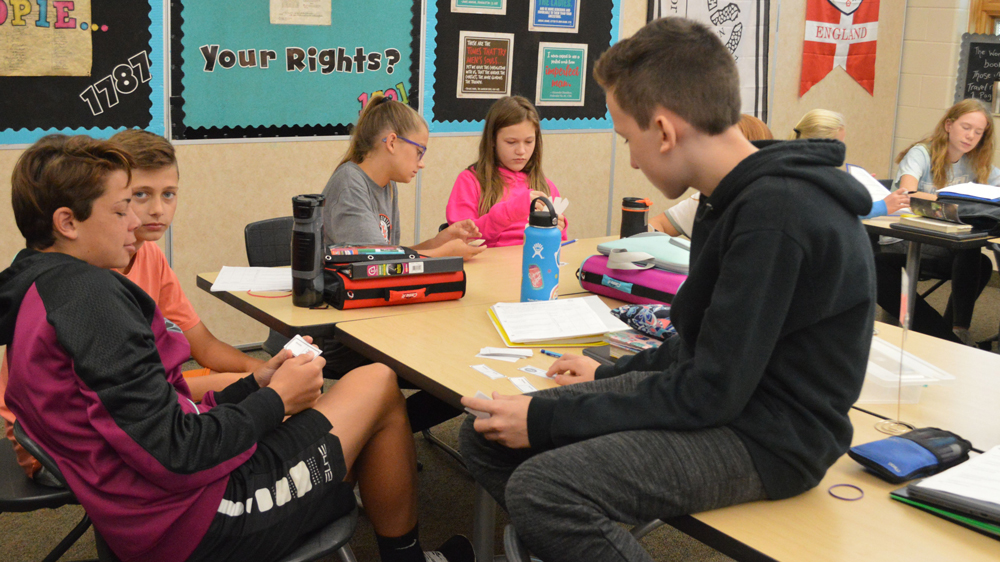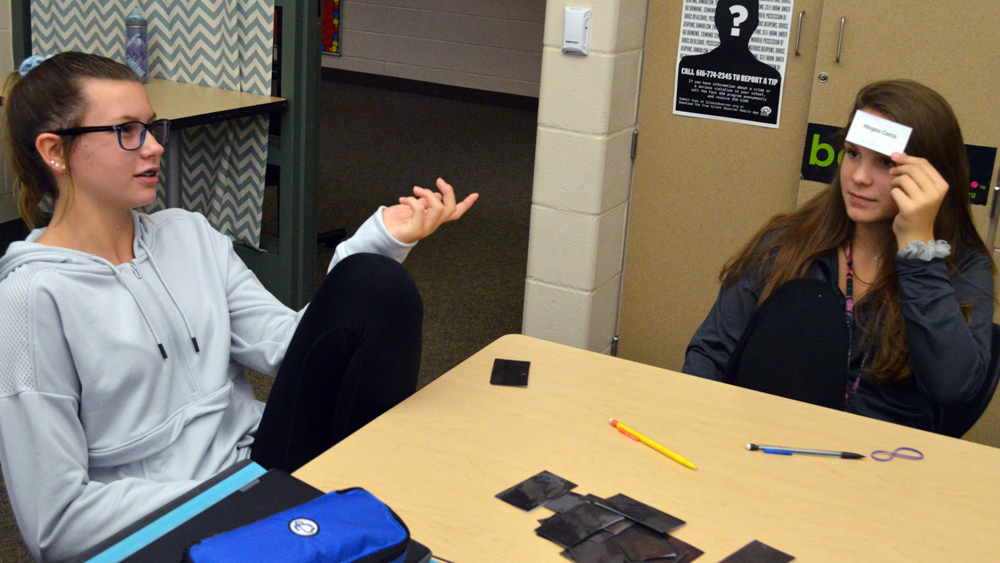Eighth grader Kylah McQueen held a game card with the words “Magna Carta” up to her forehead, though she didn’t yet know what it said.
Classmate Bria Umlar offered an important clue: “It’s an ancient document from like 800 years ago.”
After Kylah identified the English charter of rights from the year 1215, students continued guessing terms they held up to their heads, like “Representative Democracy,” “Individual Rights” and “Social Contract.”
The game wasn’t the only activity involving clues in the social studies classroom during the first week of school. The West Middle School students had already investigated a crime scene to solve a murder mystery.
And while that might sound fitting for forensics class, what does sleuthing have to do with history?
Teacher Becky Debowski explained.
“Because I tell them a detective does the same work as a historian,” Debowski said. “A historian wasn’t there, so a historian has to gather clues to infer and figure out what happened. I explain to them that sometimes a historian is not right — they weren’t there and they might not have all the clues. As we go through the year, I am going to give them as much information as I can, but history is always evolving and changing, because we don’t have all of the pieces yet.
“That framework becomes more engaging for the kids, because it’s not something they have to memorize. (History) is something they have to engage with and they have to piece together.”
Jumps in Achievement
Here’s another topic to investigate. How does one middle school manage to soar beyond most others in how students perform in subjects like social studies?
At West Middle School, 78.1 percent of eighth graders scored proficient or advanced on the 2018-2019 social studies M-STEP — the highest in Kent County and among the top five in the state. That shows:
- An improvement at West; those scores are up from 66.4 percent in 2017-2018 — an 11.9 percent bump;
- Scores that are much higher than average. In 2018-2019, 31.6 students in all Kent ISD schools scored proficient or advanced on this portion of the M-STEP. Statewide, 28.1 percent of students were in those categories;
- An improvement for students, themselves. The same cohort of students who were eighth graders in 2018-2019 did not do nearly as well in social studies as fifth graders in 2015-2016. Then, just 40 percent scored proficient on that category of the M-STEP.
It’s a similar story in West Middle’s seventh grade math classroom, which also posted top M-STEP scores in Kent County and 18th in the state:
- Students’ scored 73 percent proficient or advanced in 2018-2019, an 8.1 percent jump from 2017-2018. Nearly half of students posted advanced scores;
- That’s also well above average. In all Kent ISD schools, 40.7 percent were proficient or advanced, and statewide 35.7 percent scored in those categories;
- This also shows an improvement in the cohort of students, who were seventh graders in 2018-2019. As sixth graders in 2017-2018, they scored 58 percent proficient or advanced.
Seventh grade English language arts scores were also up: 67.7 percent proficient or advanced in 2018-2019 compared to 62.7 percent in 2017-2018 — a 5 percent increase.

Engaging Instruction, On-point intervention
Debowski and seventh grade math teacher Amy Wauben explained what’s working in their classrooms. They said they are continuously aware of what each student is grasping – and they make sure students themselves know what they need to keep studying and when they are ready to move on.
Debowski jotted down a circular flow map on a Post-it note to explain the process. It involves writing tests, effective teaching, and assessing results.
But it doesn’t take Sherlock Holmes to know what’s happening goes beyond numbers.
“I think it’s all about giving them ownership of their learning,” Debowski said. “I think the less that I’m standing in front of them talking at them the better. I do very little of that.”
Sidenote: Demoski’s so passionate about her subject matter that she caught the attention of The New York Times, who featured her classroom in an article about much-debated state social studies standards.
She immerses her class in projects that involve role-playing events from history, experimenting, investigating and ultimately connecting the past to current events. She and the school’s other eighth grade social studies teachers, Allie Utting and Devin Purdy, all plan together.
In math, Wauben said she and teacher Chelsea Freiman have the same philosophy. “I have our kids lead the learning too. They are in charge of their own learning.”
Teachers also continuously work with math and English language arts interventionists — not monthly or weekly, but every day.
“There is constant evaluation on how each kid is dong with each standard. Every week different students are receiving interventions,” said Principal Jeff Wierzbicki.
Staff Works Together
That level of individual student attention requires a lot of collaboration, and the district does that through Professional Learning Communities, or PLCs. In them, teachers and administrators work together by grade level, subject area and between buildings to streamline efforts, learn from one another and hold themselves and one another accountable. Together, teachers consider if students are understanding the content and which students need intervention.
“We know right now all of our students who are advanced, proficient, on the bubble or (below grade level),” Wierzbicki said.
If students need to learn content from prior grades, they see lead interventionist Bethany Singer.
“It starts with extremely effective teaching in the classrooms,” Singer said, crediting the staff for the high achievement. “I fill in foundational gaps to give them the additional support of perhaps things they haven’t mastered in the past.”
Wierzbicki said he believes another factor in the success is reaching students socially and emotionally. Students not only set personal goals and discuss character-building traits. School staffers use Restorative Practices, a proactive approach to discipline that gets to the “why” of student behavior, and focuses on righting wrongs and repairing harm rather than punishment that isolates students by removing them from school.
“We are emphasizing the social and emotional growth of students,” Wierzbicki said. “I may not be able to show that on a spreadsheet, but I know that’s taking place and we’ve had extra emphasis on it here that last two years.”
In Debowski’s classroom, students themselves considered why they are seeing such good results. It doesn’t seem like much of a mystery to them.
“It’s because of the teachers,” said Kylah McQueen.
“They make sure every individual student knows what they need to know,” agreed classmate Bella Teller. Added Stacy Wheeler, “You feel comfortable about asking questions.”











